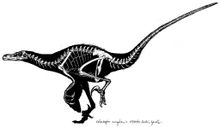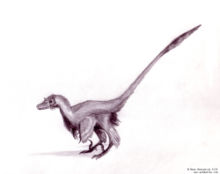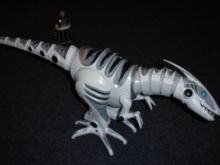Velociraptor
2007 Schools Wikipedia Selection. Related subjects: Dinosaurs
| iVelociraptor |
||||||||||||||||||||||
|---|---|---|---|---|---|---|---|---|---|---|---|---|---|---|---|---|---|---|---|---|---|---|
 Velociraptor skeletal anatomy, showing enlarged hind claw.
|
||||||||||||||||||||||
|
|
||||||||||||||||||||||
|
Extinct (fossil)
|
||||||||||||||||||||||
| Scientific classification | ||||||||||||||||||||||
|
||||||||||||||||||||||
|
|
||||||||||||||||||||||
| Velociraptor mongoliensis Osborn, 1924 |
||||||||||||||||||||||
|
|
||||||||||||||||||||||
|
Osborn, 1924 ( nomen nudum) |
Velociraptor (meaning "swift thief") is a genus of dromaeosaurid theropod dinosaur that existed approximately 83 to 70 million years ago during the later part of the Cretaceous Period. There is only one universally recognized species, V. mongoliensis, although others have been attributed in the past. Fossils of this species have been found in central Asia, from both Inner and Outer Mongolia.
Smaller than other dromaeosaurids like Deinonychus and Achillobator, the turkey-sized Velociraptor nevertheless shared many of the same anatomical features. It was a bipedal carnivore with a long, stiffened tail and had an enlarged, sickle-shaped claw on each hindfoot, which is thought to have been used to kill its prey. Velociraptor can be distinguished from other dromaeosaurids by its long and low skull, with an upturned snout.
Due in large part to its prominent role in Michael Crichton's novel Jurassic Park and the subsequent motion picture series, Velociraptor (commonly shortened to 'raptor') is one of the dinosaur genera most familiar to the general public. It is also well-known to paleontologists, with over a dozen recovered fossil skeletons — the most of any dromaeosaurid. One particularly famous specimen shows a Velociraptor locked in combat with a Protoceratops.
Description
Velociraptor was small for a dromaeosaurid, with adults measuring up to 1.798 meters (5.9 ft) long, 0.62 meters (2 ft) high at the hip, and weighing 20 kilograms (45 lb). The skull, which grew up to 249 millimeters (9.80 in) long, was uniquely up-curved, with a concave upper surface and convex lower. The jaws were lined with 26–28 widely-spaced teeth on each side, each more strongly serrated on the back edge than the front — possibly an adaptation that improved its ability to catch and hold fast-moving prey.
Velociraptor, like other dromaeosaurids, had three strongly-curved claws on each forelimb and large 'hands', which were similar in construction and flexibility to the wing bones of modern birds. Of the three digits present, the first was shortest and the second longest. The structure of the carpal bones prevented pronation of the wrist and forced the 'hands' to be held with the palmar surface facing inwards (medially), not downwards. Unlike most theropod dinosaurs, which had three functional toes on the hindlimb, dromaeosaurids like Velociraptor walked on only their third and fourth digits. The first digit, as in other theropods, was a small dewclaw. The second digit, for which Velociraptor is most famous, was highly modified and held retracted off of the ground. It bore a relatively large, sickle-shaped claw, typical of dromaeosaurid and troodontid dinosaurs. This enlarged claw, up to 67 millimeters (2.6 in) long around its outer edge, was most likely a predatory device, used to tear into the prey, possibly delivering a fatal blow.
The tail of Velociraptor was stiffened, both by long bony projections (prezygapophyses) from the upper surfaces of the vertebrae and by ossified tendons underneath. The prezygapophyses began on the tenth tail (caudal) vertebra and extended forward to brace four to ten additional vertebrae, depending on position in the tail. The stiffening forced the entire tail to act as a single rod-like unit, preventing vertical motion between vertebrae. However, at least one specimen preserves a series of intact tail vertebrae in an S-shaped curve, suggesting that there was considerably more horizontal flexibility. These adaptations of the tail probably provided balance and stability while turning, especially at high speeds.
History
An American Museum of Natural History expedition to the Mongolian Gobi desert in 1922 recovered the first Velociraptor fossil known to science: a crushed but complete skull, associated with one of the raptorial second toe claws. Two years later, museum president Henry Fairfield Osborn mentioned the animal in a popular press article, under the name "Ovoraptor djadochtari" (not to be confused with the similarly named Oviraptor). However, because the name "Ovoraptor" was not published in a scientific journal or accompanied by a formal description, it remained a nomen nudum ("naked name"), and the name Velociraptor retains priority. Later that year, Osborn designated the skull and claw (which he assumed came from the hand) as the type specimen of his new genus, Velociraptor. This name is derived from the Latin words velox (meaning 'swift') and raptor (meaning 'robber' or 'plunderer') and refers to the animal's cursorial nature and carnivorous diet. Osborn named the type species V. mongoliensis after its country of origin.
While North American teams were shut out of Mongolia, during the Cold War, expeditions by Soviet and Polish scientists, in collaboration with Mongolian colleagues, recovered several more specimens of Velociraptor. The most famous is part of the legendary "Fighting Dinosaurs" specimen, discovered by a Polish-Mongolian team in 1971. This fossil preserves a single Velociraptor in the midst of battle against a lone Protoceratops.
Between 1988 and 1990, a joint Chinese-Canadian team discovered Velociraptor remains in northern China; joint Mongolian-American expeditions to the Gobi, led by the American Museum of Natural History and the Mongolian Academy of Sciences, turned up several well-preserved skeletons between 1990 and 1995.
Provenance
All known specimens of Velociraptor mongoliensis were discovered in the Djadochta Formation of the Mongolian province of Ömnögovi, or of Chinese Inner Mongolia. A species of Velociraptor, possibly V. mongoliensis, is also preserved in the slightly younger Barun Goyot Formation of Mongolia. These geologic formations are estimated to date back to the Campanian stage (about 83 to 70 million years ago) of the Late Cretaceous Epoch.
V. mongoliensis has been found at many of the most famous Djadochta localities. The type specimen was discovered at the Flaming Cliffs site (also known as Bayn Dzak and Shabarakh Usu), while the "Fighting Dinosaurs" were found at the Tugrig locality (also known as Tugrugeen Shireh). More recently, fossils of V. mongoliensis were recovered from Bayan Mandahu, a prolific site from the Djadochta of Inner Mongolia in China. A dromaeosaurid skull, currently known only as IGM 100/1015, was recovered from the site called Ukhaa Tolgod and may represent a new species of Velociraptor, but is not V. mongoliensis. The well-known Barun Goyot localities of Khulsan and Khermeen Tsav have also produced remains which may also belong to the genus Velociraptor.
All of these sites preserve an arid environment with fields of sand dunes and only intermittent streams, although the younger Barun Goyot environment seems to have been slightly wetter than the older Djadochta. Aside from Protoceratops, upon which it preyed, Velociraptor shared its environment with other basal ceratopsians, like Udanoceratops and ankylosaurids, like Pinacosaurus, along with several species of oviraptorid, troodontid, and alvarezsaurid theropods.
Taxonomy
Velociraptor is a member of the subfamily Velociraptorinae, a derived sub-group of the larger family Dromaeosauridae. In phylogenetic taxonomy, Velociraptorinae is usually defined as "all dromaeosaurs more closely related to Velociraptor than to Dromaeosaurus." Dromaeosaurid classification is highly variable. Originally, the subfamily Velociraptorinae was erected solely to contain Velociraptor. Other analyses have included other genera, usually Deinonychus and Saurornitholestes. A recent cladistic analysis indicated that this subfamily may only contain Deinonychus and the specimen IGM 100/1015, which may be a species of Velociraptor.
In the past, other dromaeosaurid genera, including Deinonychus and Saurornitholestes, have sometimes been classified with Velociraptor within a single genus. Since Velociraptor was the first to be named, the species Deinonychus antirrhopus and Saurornitholestes langstoni were sunk into Velociraptor, as V. antirrhopus and V. langstoni. However, the only currently recognized species of Velociraptor is V. mongoliensis.
When first described in 1924, Velociraptor was placed in the family Megalosauridae, as was the case with most carnivorous dinosaurs at the time (Megalosauridae, like Megalosaurus, functioned as a sort of 'wastebin' taxon, where many unrelated species were grouped together). As dinosaur discoveries multiplied, Velociraptor was later recognized as a dromaeosaurid. All dromaeosaurids have also been referred to the family Archaeopterygidae by at least one author (which would, in effect, make Velociraptor a flightless bird).
Whether Velociraptor was a bird or a dinosaur depends on the definition being used. Phylogenetically, all members of the clade Aves are dinosaurs. However, in Linnean taxonomy and common terminology, a "bird" is not just a member of Aves but any animal with feathers. Under the latter definition, Velociraptor and all maniraptoran dinosaurs are actually birds, since feather-bearing animals are known from every maniraptoran group. Recently, fossils of dromaeosaurids more primitive than Velociraptor have been found in China, with feathers covering their bodies and fully-developed, feathered wings. In light of this, it is most likely that Velociraptor bore feathers too, since even flightless birds today retain most of their feathers. While there is, as yet, no fossil evidence to confirm that Velociraptor had feathers, there is no reason to suspect it of being an exception.
It has been recently suggested that Velociraptor and other dromaeosaurids were true birds, both under the phylogenetic definition and under the common usage of the word. Basal dromaeosaurids, such as Microraptor and Rahonavis, have been found to have had even more bird-like characters than derived forms like Velociraptor, some even having flight capability - possibly indicating that Velociraptor was secondarily flightless, like an ostrich. The discovery, in 2005, of the Thermopolis specimen of Archaeopteryx, which preserves a dromaeosaurid-like hyperextendible second toe, may mean that Archaeopteryx itself is more basal than Velociraptor. If this is true, then all dromaeosaurids must be considered true birds and members of Aves by definition, as Aves is defined to include Archaeopteryx, all living birds and all descendents of their most common ancestor.
Paleobiology
Predatory behaviour
The "Fighting Dinosaurs" specimen, found in 1971, preserves a Velociraptor and Protoceratops in combat and provides direct evidence of predatory behaviour. When originally reported, it was hypothesized that the two animals drowned. However, taking into account the fact that the animals were preserved in ancient sand dune deposits, it is now thought that the animals were buried in sand, either from a collapsing dune or while trapped in a sandstorm. Burial must have been extremely fast, judging from the lifelike poses in which the animals were preserved. Both forelimbs and one hindlimb of the Protoceratops are missing, which has been seen as evidence of scavenging by other animals.
The distinctive claw, on the second digit of dromaeosaurids, has traditionally been depicted as a slashing weapon; its assumed use being to cut and disembowel prey. In the "Fighting Dinosaurs" specimen, the Velociraptor lies underneath, with one of its sickle claws apparently embedded in the throat of its prey, while the beak of Protoceratops is clamped down upon the right forelimb of its attacker. This suggests Velociraptor may have used its sickle claw for precision killing by piercing vital organs such as the jugular vein, carotid artery, or trachea (windpipe) rather than slashing the abdomen. The inside edge of the claw was rounded and not at all sharp, which may have precluded any sort of cutting or slashing action, although only the bony core of the claw is known, so the keratin sheath may have had a sharper edge. However, it is unlikely that any sharp edge could be maintained, as the claw was not retractable for its protection, nor could it easily be sharpened by scraping against other objects, as seen in cats. The thick abdominal wall of skin and muscle would have been difficult to slash with such a dull cutting surface. The slashing hypothesis was tested during a 2005 BBC documentary, The Truth About Killer Dinosaurs. The producers of the program created an artificial Velociraptor leg with a sickle claw and used a pork belly to simulate the dinosaur's prey. The sickle claw did not fully penetrate the abdominal wall, indicating that the claw was not used to disembowel prey.
Remains of Deinonychus, a closely related dromaeosaurid, have commonly been found in aggregations of several individuals. Deinonychus is also occasionally found in association with a larger herbivore, Tenontosaurus, which has been seen as evidence of cooperative hunting. However, although many fossils of Velociraptor and other dromaeosaurids have been found in Mongolia, all have been isolated specimens not closely associated with any others. Therefore, while Velociraptor is commonly depicted as a pack hunter, as in the movie Jurassic Park, no fossil evidence currently supports this theory.
Metabolism
Velociraptor was probably warm-blooded to some degree, as it required a significant amount of energy to hunt. Modern animals that possess feathery or furry coats, like Velociraptor likely did, tend to be warm-blooded, since these coverings function as insulation. However, bone growth rates in dromaeosaurids and some early birds suggest a more moderate metabolism, compared with most modern warm-blooded mammals and birds. The kiwi is similar to dromaeosaurids in anatomy, feather type, bone structure and even the narrow anatomy of the nasal passages (usually a key indicator of metabolism). The kiwi is a highly active, if specialized, flightless bird, with a stable body temperature and a fairly low resting metabolic rate, making it a good model for the metabolism of primitive birds and dromaeosaurids.
In popular culture
Velociraptor is well-known in its role as a vicious and cunning killer, from the 1990 novel Jurassic Park by Michael Crichton, and its 1993 film adaptation, directed by Steven Spielberg. The "raptors" portrayed in Jurassic Park were modelled after a slightly larger relative, Deinonychus, which some scientists at the time called Velociraptor antirrhopus. The paleontologists in the film and the novel excavate a Velociraptor skeleton in Montana, where Deinonychus fossils would be found, far from the central Asian range of Velociraptor. A character in Crichton's novel also states that "...Deinonychus is now considered one of the velociraptors", indicating that Crichton used this taxonomy, though the "raptors" in the novel are referred to as V. mongoliensis.
The Velociraptor depicted in the Jurassic Park films were scientifically inaccurate in numerous ways. One major discrepancy, possibly explained by the fact that Deinonychus was used as a model, is that the size of the Velociraptor in the film was much greater than their diminutive real-world counterparts. The size of the film's Velociraptor may also have been increased for dramatic reasons by director Steven Spielberg. The film versions of Velociraptor were also covered in scales. No evidence of body scales has been reported for any maniraptoran dinosaur and it is more likely that they were covered in feathers, though no direct fossil evidence of integument of any kind exists for Velociraptor itself. Jurassic Park III does depict a type of feathers on its Velociraptor, quill-like structures along the back of the head and neck, although these do not resemble the down-like feathers known from real-life dromaeosaurids. Additionally, the forelimbs of the film animals did not closely resemble those of real dromaeosaurids and their tails were too short and flexible, anatomical errors which directly contradict fossil evidence. In the sequel film Jurassic Park III, one character states that Velociraptor were smarter than dolphins, whales and primates. Based on fossil evidence, this is highly unlikely, and it is more probable that, while intelligent by dinosaur standards, they were less intelligent than modern big cats.
Since the success of Jurassic Park, Velociraptor has become a ubiquitous representation of dinosaurs in popular culture. It has appeared in several other films and television programs, including several of The Land Before Time animated films and a spin-off of the Transformers television series, Beast Wars. Velociraptor was also featured in three documentary programs, The Discovery Channel's Dinosaur Planet, most notably a female trying to locate a pack, a special of the BBC's Walking With... series (" The Giant Claw"), attacking a Protoceratops and The Truth About Killer Dinosaurs, another BBC production which featured Velociraptor in an animated fight with an Ankylosaurus.
Velociraptor has also appeared in the realms of music and sport. For example, the Toronto Raptors, an NBA franchise, adopted a stylised Velociraptor as their logo, while the band Norma Jean named their 2005 tour the "Velociraptour". There is also a robotic toy based on Velociraptor, called Roboraptor. Aside from titles based on Jurassic Park, Velociraptor has also been featured in other video games, including the Dino Crisis series, Carnivores, and World of Warcraft.
- Dinobot's beast form in the Beast Wars television series was that of a Velociraptor.



